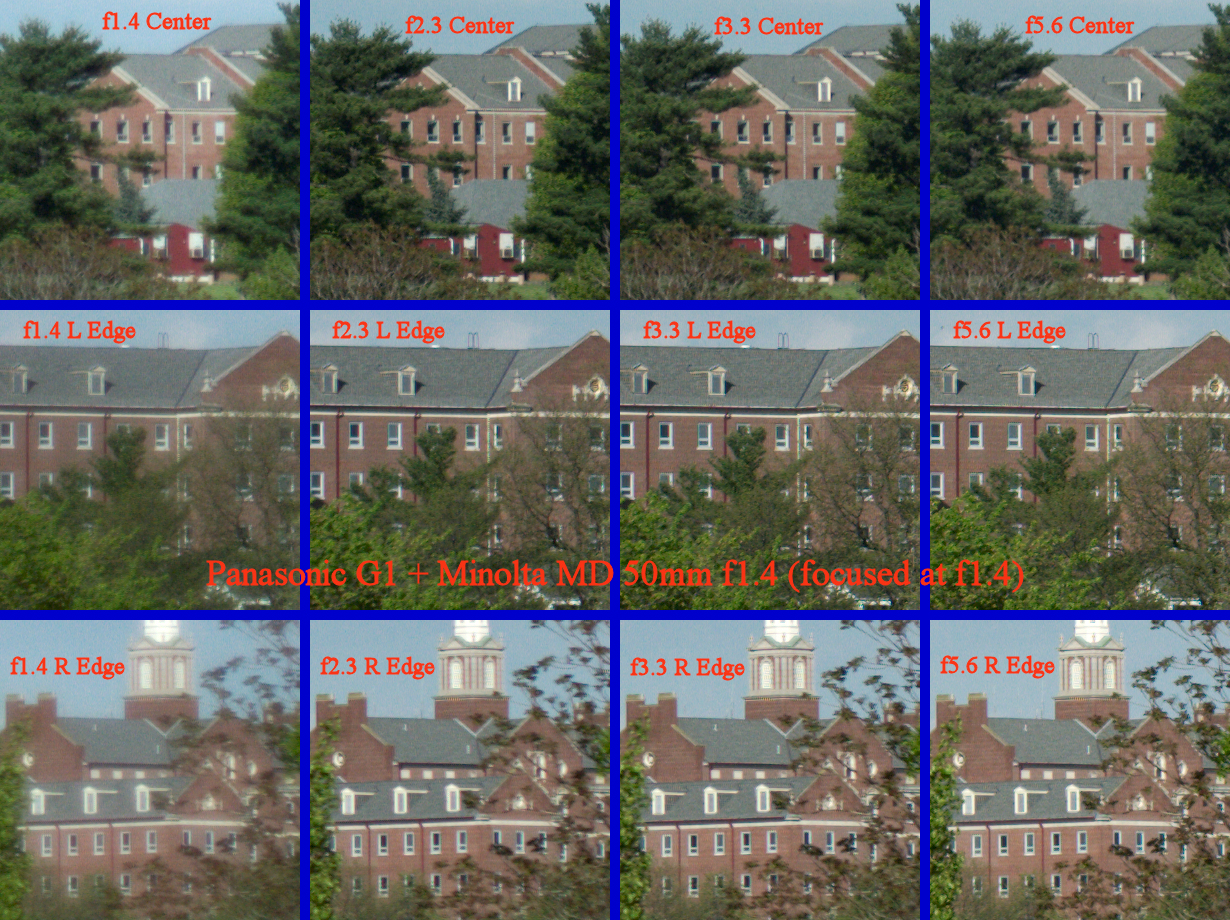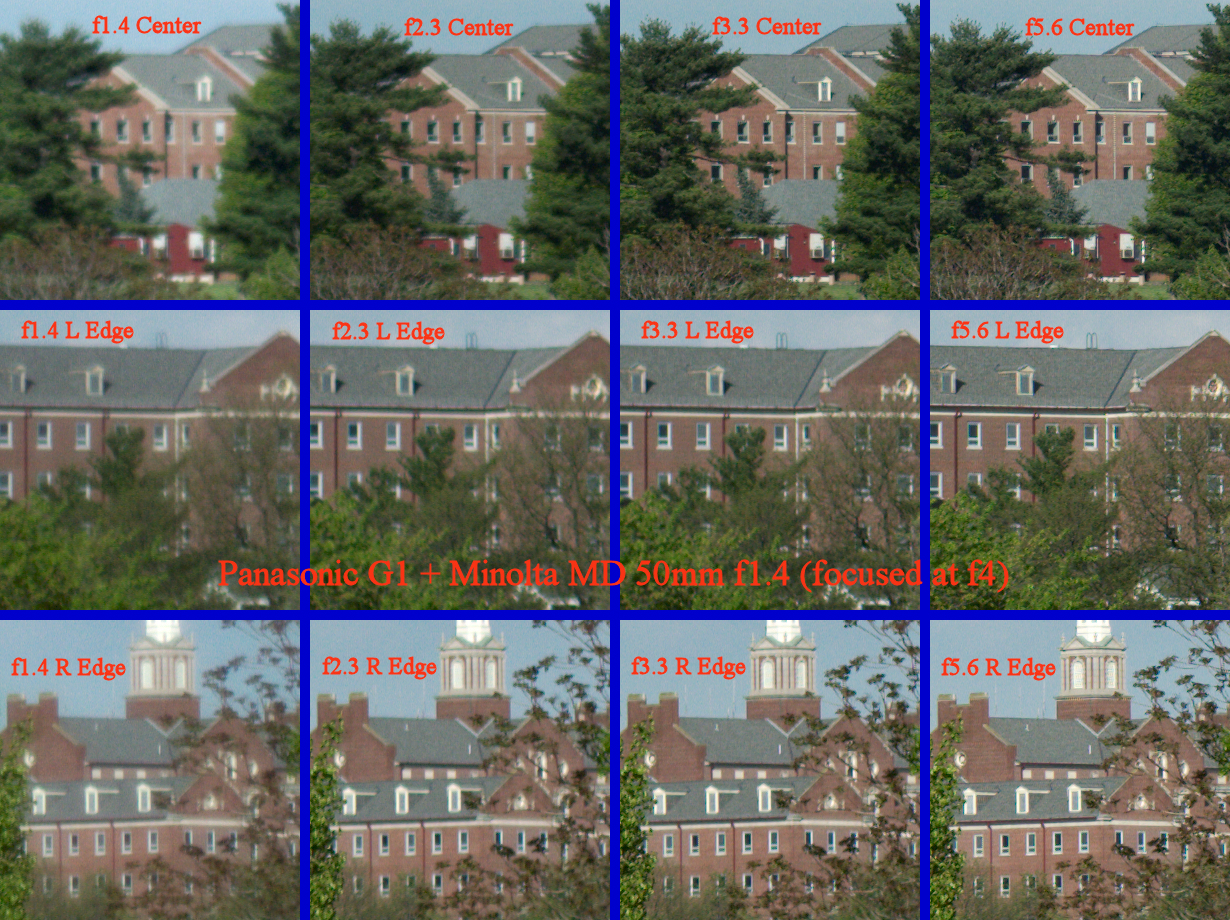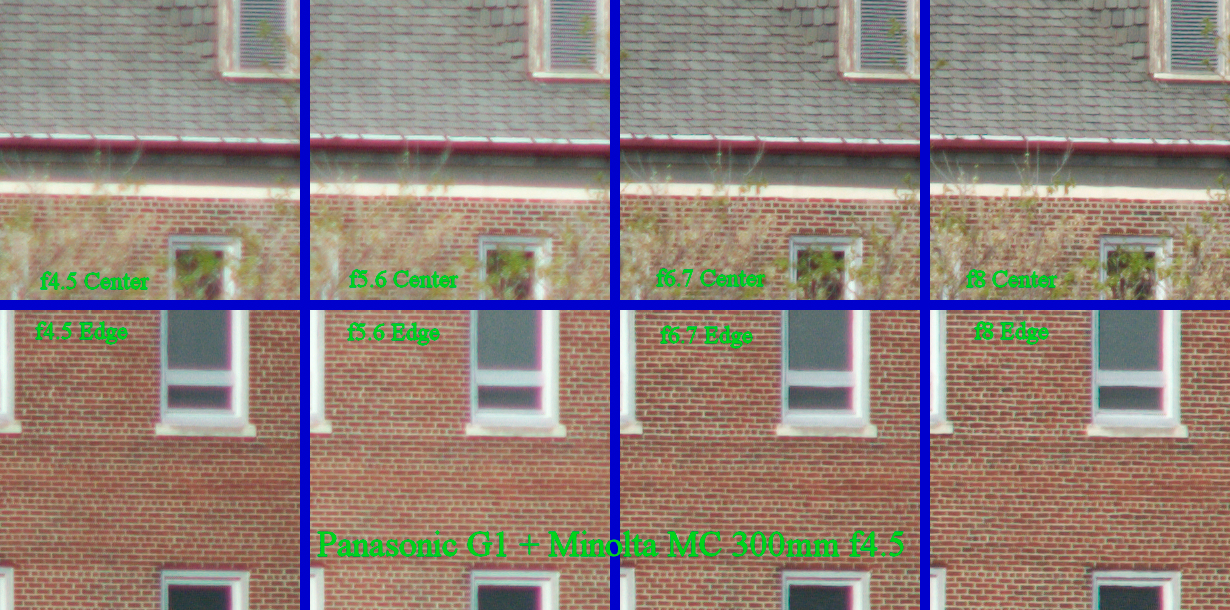Quote of the day: "As I would not be a slave, so I would not be a master. This expresses my idea of democracy. " --Abraham Lincoln
These tests were done on May 8, 2011. The camera was my Panasonic G1 purchased in Decmeber, 2010. The camera was mounted on a Gitzo 1541 carbon fiber tripod with an Acratech ballhead. The shutter was triggered using a Panasonic wired remote shutter release. The weather conditions were a mix of sun and clouds and a light wind. I attempted to make sure the buildings in the distance were not in shadow, although there may be some variation in lighting. Since the purpose of the tests was to determine the sharpness and contrast of the lenses at various apertures, the varied lighting conditions were not deemed a hindrance (as they would be if vignetting was being measured--not an issue with full frame lenses on a 4/3 sensor camera). The buildings in the distance were approximately 1/4 mile from the camera position. All lenses were focused manually using the G1 LCD magnification feature.
The images were postprocessed from RAW files using the AdobeRGB color space. No sharpening was applied to the crops. The files were converted to the sRGB color space when they were converted from TIFF to JPEG. A Fotodiox lens adapter was used to mount the lenses on the Panasonic G1. This adapter is well made and the lenses fit snugly with no play. However, all the tested lenses focused past infinity, which may be a design choice by Fotodiox to make sure all possible Minolta MF mount lenses (including those make by third-party manufacturers) can achieve infinity focus.
Note: Sample variation is always an issue when testing lenses. A single lens may not be indicative of the average lens performance. The lenses I am testing are my own, for the purpose of determining whether they are worth keeping in my photo backpack. Your lens may be different...
Due to the unusual characteristics of the test done on April 25, 2011 this lens was tested again. In the previous test the image quality was worse at f5.6 than it was at f3.3, which was unexpected. I thought it may have been possible that I accidently changed focus as I was changing aperture, so I did more testing. During the testing I noticed that there was a difference in image quality when I focused at f1.4 and f4--all the previous lens tests were done by focusing wide open but I decided to try focusing stopped down to see if it might improve the performance at f5.6. There are two series of images shown below, one focused at f1.4 and one focused at f4. I felt f4 was a good compromise between being stopped down and not having too large a depth of field. As the results show, focusing at f4 did significantly improve the image quality at f5.6. Some Internet research revealed that spherical abberation is the likely cause of the focal plane shift when stopping down. Spherical abberation is common on fast lenses like a 50mm f1.4. In the past I always assumed it was better to focus wide open however, as this test shows, for some lenses it is better to focus stopped down (for a fast lens, 3 stops is probably aqequate to remove the majority of the spherical abberation--I still would rather focus at f4 even if I was shooting at f8, since a large DOF makes precise focusing more difficult).
After the original test I stated that I would not carry this lens in my bag. However, due to the discovery of the spherical abberation issue I have to retract that statement. This lens is worth having in my bag, although I plan to get a macro of this focal length soon which means I will probably not carry the Minolta 50mm.
Note: It may appear strange to see f2.3 and f3.3 crops, since these are half-stops in between the "standard" aperture settings. My justification for this is that on MD lenses the first aperture stop after wide open is supposedly a full stop (the next stop after f1.4 on the 50mm of f2) but based on exposure readings on the G1 this is usually not a full stop (usually 2/3 of a stop). The reason for this is the small sensor size of the G1, such that the first stop actually has less impact on the amount of light reaching the sensor as compared to 35mm film. Therefore, I decided to present data for the next half-stop so that the effect of the aperture change is more pronounced.
Note: All the images were shot using a B+W neutral density filter due to the 1/4000 maximum shutter speed limitation of the Panasonic G1. In the previous test I only used the ND filter on the f1.4 exposure--in this case I used it for all the exposures to eliminate any effect due to removing the filter.


This lens was another camera shop find. I purchased it used sometime in the early 1990's. It is much older than my other Minolta lenses--the finish has much more wear and the focusing ring does not have a rubber coating. The lens coating is different from my MD models, and it may single coated instead of multi-coated. There is also some damage to the coating which appears to be from abrasion (as if the lens rubbed against something). Due to its age and the issue with the coating I purchased the lens for a small amount of money. I have not used the lens often as I rarely shoot long distance subjects. One other issue with the lens is that the focusing action is not smooth, most likely due to its age. It was difficult to be precise when focusing the lens for the test so some error may have occurred.
The results of the test are mixed. The lens is somewhat soft in the center at f4.5, although the edge performace may be a bit better. There may be an exposure variation at f5.6 which appears to have less contrast, although at f6.7 and f8 the center is somewhat sharper than wide open and has better contrast. The edge performance also seems a bit better stopped down than wide open, although not dramatically so. The one issue with the lens is color fringing, which improves in the center by f8 but does not improve as much at the edge. This can be corrected with software so it does not render the lens unusable, however I'm not likely to use this lens very often anyway. It is big and heavy, and I believe a more modern lens would have better optical quality. Furthermore, the maximum aperture is only f4.5 which is not much better than some micro 4/3 zoom lenses.
